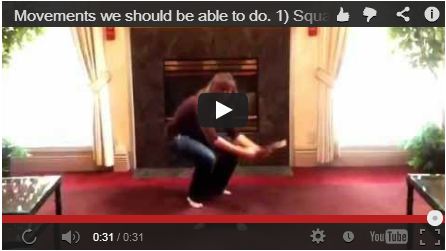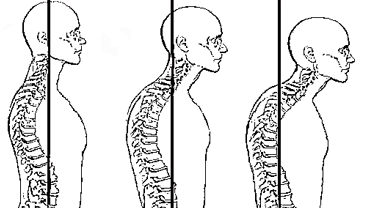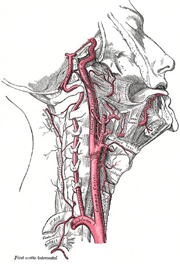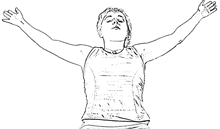I was asked to write an article on running. Here are some ideas that I think may help runners improve their ability while staying pain free.
Standing Posture
Because posture is the place from which movement begins and ends, having good static posture will greatly enhance running ability, while having poor static posture will be detrimental to running or any other sport for that matter, and may even be the cause of injury.
If our posture is poor and the joints cannot maintain a proper axis of rotation, the joints may suffer wear and tear. Imagine a garden gate that is not hung straight – the hinge on that gate is not properly aligned. It squeaks with use, and if the gate is continually used in its poorly aligned position, the hinge will eventually wear out. Our joints are the same.
If our static posture is good, the muscle balance about every joint in the body will be even, meaning that the joint can maintain its instantaneous axis of rotation throughout the range-of-motion. Good posture is the foundation for great running.
To get into the best posture possible, stand up, feet shoulder distance apart, and move your pelvis forward and back until you have found the place where you can feel the weight of your trunk going through the leg bones and out the feet into the floor. The thigh and buttock muscles are relaxed.
Then pick your ribcage up off of your pelvis as best you can, making yourself as tall as possible. Relax your shoulders and arms on your heightened ribcage. You may feel a sensation of decompression in your lumbar spine, and you may be aware of a muscle in your lower abdomen turning on.
Now, lift the base of your skull at the back of your head as high as you can, so that you are as tall as you can be throughout your body. Try to separate your shoulders as far away from each other, so you are also as wide as you can be.
The end result of this effort should be that your pelvis is directly over your legs, your ribcage is directly over your pelvis without tilting forward nor backward, and your shoulders are sitting squarely on the platform of your ribs, and your head is directly over your ribs, with the plane of your face vertical.
Practice this as you go through your day, as you sit, and as you walk. The feeling should be that your legs are floating under you as you walk, not that you are using muscle effort to move your legs.
There is a definite sense of ease. Experiment with how this sense of being as tall as possible creates ease in your running. This will assist in activating your deep stabilizers, which will keep your back and pelvis healthy while you run.
If you want a better understanding of how the deep trunk stabilizers work, and specific exercises to target them, feel free to purchase our exercise DVD – we included a whole section on it, as well as exercises in the work-out geared to help strengthen this area.
Adequate Flexibility
Having good flexibility in the legs and trunk will help you run faster, as you will be able to increase your stride length. Poor flexibility may put you at risk for muscle pulls and tears, particularly in the calves, hamstrings and possibly quads if you are a sprinter.
Tightness in the quads (front of the thigh) and TFL / IT band (side of the upper leg) is often the key reason for knee pain in runners, as the tightness pulls the kneecap out to the side so it is no longer sliding properly in the knee groove.
Furthermore, tightness in the front of the hip area makes it impossible to get adequate hip extension while running, so the glute
max, the main powerhouse muscle needed for running would not be firing adequately. Impossible to run fast without the glutes!
Tightness in the inner thigh will pull the knee into the midline, leading to instability in the hip (gluteus medius weakness), potentially creating hip, knee or ankle pain.
And tight hipflexors, quads, calf, shin, bottom surface of the feet and toes can be a primary cause of Achilles tendon problems as well as plantar fasciatis (pain on the bottom surface of the foot and heel).
To run well, one needs to be able to rotate the trunk and pull with the arms, so anything restricting those motions will lead to overuse of something else further down the chain to compensate for the lack of motion above.
Muscles and fascia might be tight, joints at the spine, ribs and sternum may be restricted, and organs, nerves and blood vessels may be tethered, all of which may compromise motion in the trunk.
Strength
For the performance-minded runner, increasing strength is important to developing power, which is needed for increasing speed.
Increased strength can also be converted to muscle endurance, which will allow you to run faster for a longer period of time. Being strong is helpful in preventing injuries, as long as you are strong without compromising flexibility.
The ability to strengthen up is often limited by tightness in the opposing muscle (as I suggested earlier). Strength-training in a manner that improves flexibility simultaneously is the most efficient way to train.
If you want some ideas on how to do this, some of the exercises in our DVD are designed specifically to increase strength and flexibility at the same time.
Muscle Endurance
Muscle endurance is defined as the number of times one can contract a muscle, as opposed to strength, which is defined as how much force can a muscle generate once. Clearly, muscle endurance is extremely applicable to running.
Even when looking at a 100 metre sprint, each foot hits the ground 40-50 times. This can hardly be classified as “strengthâ€. Even in the gym when training muscle endurance, the rep range most usually considered is 15-20 repetitions, which is too low, even for sprint training.
It is muscle endurance that is going to get you through your run. It will allow you maintain proper running mechanics throughout the distance and therefore keep you injury free.
Running Technique
Learning proper running technique will make a huge difference to running efficiency as well as to preventing injuries. Developing the essential motor patterns to correct running is well worth the effort, and more time should be spent on this initially than on increasing mileage.
Increasing mileage using poor form will simply engrain bad habits that become harder and harder to change with every kilometer you run. By practicing good technique, you are running smarter, and in the long run, you will run better, longer, faster.
The best way to do this is to run barefoot or in minimalist shoes as they will force you to avoid landing on your heel, improving running mechanics immediately as your bodyweight will be more over your foot as your foot strikes the ground.
If the heel hits first, the foot is landing too far forward of the body, and
the heel acts like a break slowing you down, because the ground reaction forces
going back up your leg are pushing you backwards.
These forces can be up to ten times your bodyweight, and are therefore often responsible for Achilles, ankle, knee, hip and occasionally low back issues.
By pawing back with the leg and landing on the midfoot instead of the heel, the braking effect is minimized, speed is increased, and injuries are reduced.
Take a lesson from a good running coach who has experience with minimalist shoes. If you are a runner with a heel-landing technique, it will take a long time to make the switch.
The first run in minimalist shoes should probably be only about 5 minutes long. Resist the temptation to up the mileage too fast. Going too far too soon will only result in injury and frustration.
Hiking with a pack on uneven terrain in minimalist shoes will help the foot and lower-leg musculature become stronger and more flexible – good training that will maintain cardiovascular fitness while you are trying to learn a new technique and can’t put in lots of running mileage.
Over time as you gradually improve your technique, you will probably find that you are able to run more comfortably, probably faster, and that those lower-leg irritations disappear.
Please do keep the comments coming! If you want to search for other posts by title or by topic, go to www.wellnesstips.ca.
Related Tips:
Take your space and improve your posture
Foot flexibility important to reducing hip and SI joint pain
Which limits function more? A lack of strength or a lack of flexibility?
Squatting and the knees
Yessis, Michael Explosive Running: Using the Science of Kinesiology to Improve Your Performance
McGraw-Hill Companies, Inc, 2000)
Dr. Cucuzella, Mark, Principles of natural running
The gait guys
Copyright 2012 Vreni Gurd






 It makes good sense that the body works best if all the blocks are stacked up properly. Pelvis right over the legs instead of in front or behind, ribs over the pelvis instead of tilting backwards, and head over the ribs so the ear is lined up over the shoulder. Seems obvious, but most of us don’t seem to live there regularly.
It makes good sense that the body works best if all the blocks are stacked up properly. Pelvis right over the legs instead of in front or behind, ribs over the pelvis instead of tilting backwards, and head over the ribs so the ear is lined up over the shoulder. Seems obvious, but most of us don’t seem to live there regularly.  When the back of the skull and the top vertebrae (OA joint) get too close together there is potential for compressing the vertebral artery and vein as they exit the transverse foramen of the top vertebrae to make their way into the cranium. Impaired blood flow into and drainage from the brain is never a good thing. (The vertebral artery is the thinner one at the back, threading through the holes in the vertebrae. This drawing is from Gray's Anatomy.)
When the back of the skull and the top vertebrae (OA joint) get too close together there is potential for compressing the vertebral artery and vein as they exit the transverse foramen of the top vertebrae to make their way into the cranium. Impaired blood flow into and drainage from the brain is never a good thing. (The vertebral artery is the thinner one at the back, threading through the holes in the vertebrae. This drawing is from Gray's Anatomy.) A simple stretch that can be done is to lie on the floor or in the middle of the bed on the back (use a small pillow if you need one), and reach the arms straight out to the side, slowly raising them up towards your head like a snow angel. When you start to feel a stretch, wait until the stretch dissipates. Do this daily. The goal is to have the upper arms resting on floor comfortably next to your ears without feeling any stretch at all.
A simple stretch that can be done is to lie on the floor or in the middle of the bed on the back (use a small pillow if you need one), and reach the arms straight out to the side, slowly raising them up towards your head like a snow angel. When you start to feel a stretch, wait until the stretch dissipates. Do this daily. The goal is to have the upper arms resting on floor comfortably next to your ears without feeling any stretch at all. Facebook Wellness-Tips Page
Facebook Wellness-Tips Page